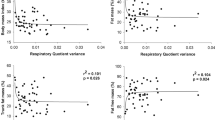Abstract
Objective: To test the hypothesis that 55–70 y old male longterm exercisers (LE) have higher resting metabolic rates (RMR) than longterm nonexercisers (LNE).
Design: A power analysis demonstrated that this cross-sectional study required 12 subjects per group to detect a 10% RMR difference (kJ · kg FFM−1 · d−1) between the LE and LNE (power=0.8; α=0.05).
Subjects: Twelve LE (X±s.d.63.5±3.4 y; 1.75±0.06 m; 69.01±8.24 kg; 20.4±4.9 %BF) and 12 LNE (63.6±5.6 y; 1.72±0.07 m; 79.44±12.4 kg; 29.6±4.4 %BF) were recruited from advertisements placed in a newspaper and on university and community noticeboards.
Interventions: Measurements were conducted for: RMR using the Douglas bag technique; body composition via a four compartment model which is based on determination of body density, total body water and bone mineral mass; and aerobic fitness using a submaximal work test on a cycle ergometer.
Results: The LE (93.00±7.16 kJ · kg−1·d−1) registered a significantly greater (P=0.04) RMR than the LNE (84.70±11.23 kJ · kg−1·d−1) when energy expenditure was expressed relative to body mass, but this difference disappeared (P=0.55) when the data were corrected for the non-zero intercept of the graph of RMR (MJ/d) against body mass. ANCOVA with FFM as the covariate also indicated that the RMR (MJ/d) difference between the groups was not statistically significant (P=0.28). The adjusted means for the LE and LNE were 6.39 and 6.62 MJ/d, respectively.
Conclusions: There are no RMR (MJ/d) differences between LE and LNE 54–71 y old males when statistical control is exerted for the effect of FFM and the higher value of the former group for RMR normalised to body mass disappears when this ratio is corrected for statistical bias.
Sponsorship: This study was supported by a joint grant from the Flinders University of South Australia and CSIRO (Australia).
This is a preview of subscription content, access via your institution
Access options
Subscribe to this journal
Receive 12 print issues and online access
$259.00 per year
only $21.58 per issue
Buy this article
- Purchase on Springer Link
- Instant access to full article PDF
Prices may be subject to local taxes which are calculated during checkout
Similar content being viewed by others
Author information
Authors and Affiliations
Contributions
Guarantor: Dr DA Smith.
Contributionship: DAS collected and analysed the data and helped to write the paper; RTW conceived the study, secured the research funding, supervised the project and wrote the paper; MB and RCT helped to collect and analyse the data; BEC and CGS conducted the DXA scans; DGC assisted with the application for research funds, co-supervised the project and helped with writing the paper.
Rights and permissions
About this article
Cite this article
Smith, D., Withers, R., Brinkman, M. et al. Resting metabolic rate, body composition and aerobic fitness comparisons between active and sedentary 54 –71 year old males. Eur J Clin Nutr 53, 434–440 (1999). https://doi.org/10.1038/sj.ejcn.1600771
Received:
Revised:
Accepted:
Published:
Issue Date:
DOI: https://doi.org/10.1038/sj.ejcn.1600771
Keywords
This article is cited by
-
Smaller size of high metabolic rate organs explains lower resting energy expenditure in Asian-Indian Than Chinese men
International Journal of Obesity (2016)
-
Impact of indexing resting metabolic rate against fat-free mass determined by different body composition models
European Journal of Clinical Nutrition (2004)


